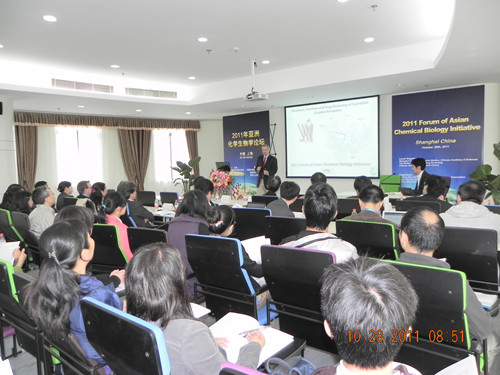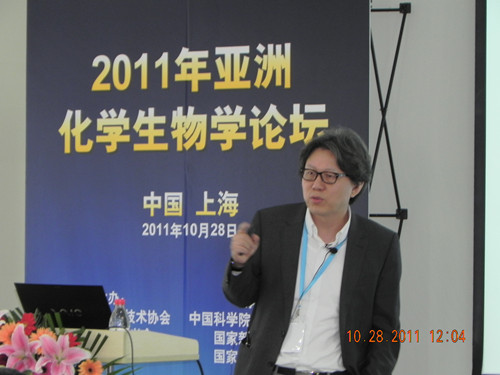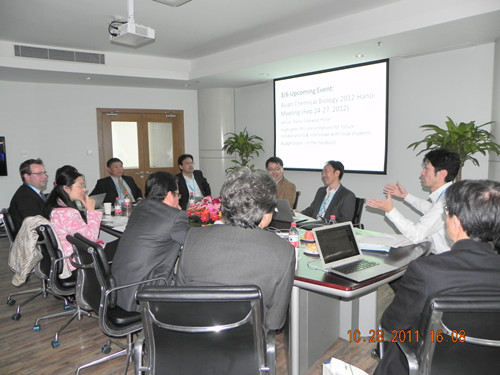Asian Chemical Biology Initiative 2011 Shanghai Meeting held in Zhangjiang
Chemical biology is an interdisciplinary field of study that is often defined as "chemistry-initiated biology". It is expected that this emerging research field will open new avenues for comtemporary drug discovery and translational medicine. "Asian Chemical Biology Initiative" has been set up by a group leading scientists from China, Japan, Korea and Singapore to speed up pan-Asia chemical biology research and to promote academic exchanges among Asian countries.
The first executive meeting of Asian Chemical Biology Initiative was held at the Chinese National Compound Library (CNCL), Shanghai on October 28, 2011, with financial support from Shanghai Municipaity and Pudong Science and Technology Association. Dr. Ming-Wei Wang, Director of CNCL, hosted the meeting together with Dr. Motonari Uesugi of Kyoto University. Professor Raymond Stevens from the Scripps Research Institute (U.S.A) delivered an invited lecture followed by a series of open seminars given by all the participating executive members (see below). The event attracted more than 100 scientists and students from a number of local universities and research institutes, as well as from Hong Kong and Guangzhou.
This newly established initiative plans to hold annual meetings over the next five years in Hanoi, Manila, Bangkok and Kuala Lumpur, where top-notch Asian chemical biologists will get together to foster mutually beneficial collaborations and to recruit postraduate students from various Asian countries. The initiative has received significant funding from Japan Society for the Promotion of Science.
- Prof. Ray Stevens (The Scripps Research Institute, U.S.A.): Structure, function, and drug discovery of the G-protein coupled receptor superfamily (invited lecture)
- Prof. Kazuya Kikuchi (Osaka University, Japan): Development of optical molecular imaging probes with tunable chemical switches
- Prof. Ho Jeong Kwon (Yonsei University, Korea): Perturbing angiogenesis using small molecules
- Prof. Young-Tae Chang (National University of Singapore, Singapore): Make invisible visible - a diversity oriented fluorescence library approach (DOFLA)
- Prof. Yan-Mei Li (Tsinghua University, China): Synthesis and immunology evaluation of MUC1 glycopeptide vaccine
- Dr. Minoru Yoshida Riken (RIKEN Institute, Japan): Chemical epigenetics
- Prof. Sunghoon Kim (Seoul National University, Korea): Chemical biology to identify druggable targets
- Prof. Motonari Uesugi (Kyoto University, Japan): Small-molecule tools for cell biology and cell therapy
- Prof. Seung Bum Park (Seoul National University, Korea): Molecular diversity and bioprobes for chemical biology
- Prof. Takeaki Ozawa (University of Tokyo, Japan): Imaging and control of biomolecules using genetically-encoded proteins
- Prof. Ming-Wei Wang (Chinese Academy of Sciences, China): Cyclobutane derivatives as novel non-peptidic small molecule agonists of glucagon-like peptide-1 receptor
 |
|
Group photo |
 |
| Professor Raymond Stevens(the left) from the Scripps Research Institute (U.S.A) delivered an invited lecture |
 |
| Prof. Sunghoon Kim, Seoul National University, Korea |
 |
| Prof. Motonari Uesugi, Kyoto University, Japan |
 |
| Prof. Ming-Wei Wang, Chinese Academy of Sciences, China |
 |
| The first executive meeting of Asian Chemical Biology Initiative was held at CNCL |
